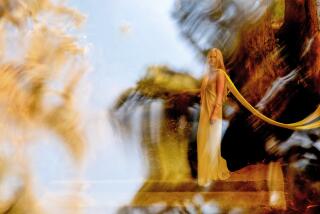The Enigma of Sappho
No poet of antiquity has been more widely adored than the Greek lyric poet Sappho, the most influential woman in world literature until modern times. Although she lived and wrote 2,600 years ago, she is vibrantly alive to us, a more distinctive companion to the reader than almost any writer who followed her, at least until Dante. Sappho is a woman one knows. She sang her verses, accompanying herself on the lyre; in the poems one hears her voice, as familiar as an old friend calling hello at the front door.
When she tells her beloved, “I loved you, Atthis, once long ago / a little child you seemed to me and graceless,” the words--here, in Anne Carson’s faithful new translation “If Not, Winter”--come as close as literature can to life, to a direct reflection of experience. How easy it would be to say instead, as a lesser poet might, that the girl she loves is graceful--and how lifeless. Yet when Sappho says that her first impression of Atthis was one of gracelessness, it has the vivid, surprising power of life.
What makes Sappho’s poetry so enduring and what makes her palpable human presence in the poems so remarkable is that we know almost nothing about her--hardly surprising, given that she lived so very long ago, more than a century before the age of Pericles and Sophocles, on the remote island of Lesbos. She probably lived in exile in Sicily for a time, a tradition bolstered by some heartbreaking poems addressed to her daughter, lamenting that she can’t dress her as she would at home.
It might be safer to say, as some recent scholars have, that in fact we know nothing at all about her except what may be gleaned from the poems--which are literature and therefore suspect. Almost everything we once thought we knew has been proved to be false. My Encyclopaedia Britannica, for example, still innocently repeats the old canard that Sappho was “married to Cercolas, a wealthy man from the island Andros”--a joke from a bawdy ancient comedy about the poet (“Cercolas” is a phallic pun, and Andros simply means “man”). There are many more legends, all of which have considerably less historical basis than George Washington’s cherry tree; the most widely known is the traditional account of Sappho’s death, that she leapt from a cliff, her heart broken by a young sailor named Phaon.
Sappho’s verse, too, has been almost entirely obliterated. Of the nine books of poems attributed to her by tradition and celebrated in the ancient world, only fragments remain, a few hundred lines that include just one complete poem, the thrilling “Hymn to Aphrodite,” and isolated words and phrases rescued from citations by ancient grammarians and rhetoricians. The destruction of the works of the poets of pagan antiquity is usually blamed on the early Christian church fathers and the crusaders. Sappho’s reputation for licentiousness provoked Pope Gregory VII to have her books publicly burned in AD 1073; according to another tradition, the last complete copy of Sappho went up in smoke with the library of Constantinople in AD 1204, when the fourth Crusade sacked the city.
The few fragments that survived have inspired readers to rapturous delight for centuries. Joseph Addison, introducing the first published English translation of the “Hymn to Aphrodite” by Ambrose Philips, in 1711, neatly captures the reason for Sappho’s perennial appeal: “Her soul seems to have been made up of love and poetry. She felt the passion in all its warmth, and described it in all its symptoms.” The Victorians were mad about her, creating a sentimental cult with titillating undercurrents. J.A. Symonds painted a gorgeous myth of life on 6th century Lesbos. In his vision, the ladies of Lesbos had unlimited freedom and leisure, which they beguiled with music, dance and poetry as they strolled in exquisite gardens, “where the rose and hyacinth spread perfume,” or along “marble cliffs, starred with jonquil and anemone in spring.” Symonds didn’t have to remind his readers that the amorous, talented women in the myth also made love to each other.
Much of classical literature, despite the protestations of popularizers, really is remote to contemporary readers; the battle scenes in the epics, the endless odes to the winners of footraces, the tips to farmers are difficult for most of us to grasp or care about. Yet Sappho is always fresh and thumping with life: In fragment 47, she declares herself: “Eros shook my mind like a mountain wind falling on oak trees.” With Sappho and love, it’s always a fight to the finish.
The fragments of Sappho constitute a compelling demonstration of the tragic power of the word, its capacity to make us feel loss as deeply as we do in life. The lines just quoted are all that survive of the original poem, recovered from a paraphrase by an obscure orator named Maximus of Tyre. We will never know what happened after Eros shook the poet’s mind, or who caused the tempest. The sensitive reader, confronted with fragment 47, must attempt something like an imaginative reconstruction of the whole poem, as it might have been. Despite the impossibility of the undertaking, the longer the lines play in the mind, the closer the lost poem comes glimmering toward the surface.
There have been many fine translations of the fragments of Sappho since Philips’ day, and now Anne Carson, a distinguished Canadian poet, offers her version. Carson restores to us the Sappho who fell in love with a girl because she reminded her of a graceless child and strips away the mawkish cliche of the odd musical lady leaping off the cliff (admittedly less of a problem now than when classical literature was widely read).
Carson is in many ways the ideal translator, an accomplished classicist who frequently writes on Hellenic themes in her own verse (among others, the brilliant book-length “Autobiography of Red,” a love story based upon the fragments of the lyric poet Stesichorus, Sappho’s near-contemporary). Her command of language is honed to a perfect edge and her approach to the text, respectful yet imaginative, results in verse that lets Sappho shine forth without a lot of fuss. Most of Carson’s translations are elegantly literal, but every now and then she sweetens the lines with a bit of traditional versification, as in this couplet, fragment 50: “For the man who is beautiful is beautiful to see / but the good man will at once also beautiful be.” The old-fashioned rendering emphasizes the lines’ sententiousness, an extremely rare quality in what survives of Sappho’s work.
Carson has arrived at a fine solution to one of the most perplexing problems of Sapphic scholarship: what to do with the heaps of papyrus dug up over the last hundred years, which are slowly enlarging the poet’s oeuvre (in some cases just a few words at a time). Since the end of the 19th century, archeologists in Egypt have excavated large quantities of tattered papyrus, shredded manuscripts of Sappho and other ancient poets, which were used to make papier-mache or simply thrown out with the garbage. Some of them consist of halves of many lines, a papyrus page torn vertically; others consist of a few isolated words.
In her translations, Carson indicates the lacunae with brackets, to give the reader a sense of the incompleteness of the papyrus. (The parallel text is also an aid here, even to readers with no Greek.) Here, for example, is her translation of fragment 93:
]
]
]
]I have
]of girls
The effect, unintentional and unavoidable, is similar to that of the quaint enigmas of concrete poetry, experimental verse from the 1950s and 1960s. The words form a shadowy little world, approaching the very threshold of nonexistence, which pushes the challenge of reconstruction to the limit.
Poets make the best translators of poetry, but they are often irritating introducers and annotators. Carson’s introduction is the weakest part of the book, five elliptical pages that include little of the basic information contained in this review. She is surprisingly reticent on the subject of Sappho’s sexuality, saying only, “It seems that she knew and loved women as deeply as she did music. Can we leave it there?” and adding a baffling quotation from Gertrude Stein to cast further darkness on the matter.
No, we can’t leave it there: Symonds and others may have made a romanticized muddle of Sappho’s life in the absence of reliable biographical information, but most readers of Sappho will wonder about the passions that produced the poetry: It’s an interesting question. After all, there is a fundamental difference between the love of music and carnal love, which Sappho’s crushes on girls have every sign of having been.
However, Carson’s notes are enormously enjoyable. She takes the reader to the very heart of the process of translation in a three-paragraph note devoted to the two words that constitute fragment 38 (which she translates “you burn me”). After justifying her rendering, she makes an admission that few scholars, if any, would be brave enough to utter: “On the other hand, I may be reading this sentence all wrong.” It’s a wonderful sentence, gleaming with a candor worthy of Sappho herself, which inspires confidence that in “If Not, Winter” Carson is getting it right, all right.
More to Read
Sign up for our Book Club newsletter
Get the latest news, events and more from the Los Angeles Times Book Club, and help us get L.A. reading and talking.
You may occasionally receive promotional content from the Los Angeles Times.






